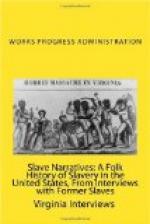When Sherman and his army marched through they burned all the gin houses on the Ormond plantation and took all the available live stock. Mr. Ormond took a few prized possessions and a few slaves (one of whom was Mr. Eason) and fled to Augusta, Ga.
After freedom was declared he was still held in bondage and hired out by the day. Once he ran away but was found and brought back. In 1867 the remaining members of the Ormond family moved to Atlanta, bringing him along with them. After most of them had died he was finally permitted to go or stay as he pleased.
Immediately after freedom had been declared he had the good fortune to find his father. However, he never got a chance to spend any time with him as the Ormonds refused to release him.
Says Mr. Eason: “Slavery had a good point in that we slaves always felt that somebody was going to take care of us.” He says that he has heard some wish for the good old days but as for himself he prefers things to remain as they are at present.
PLANTATION LIFE AS VIEWED BY EX-SLAVE
CALLIE ELDER, Age 78 640 W. Hancock Avenue Athens, Georgia
Written by:
Sadie B. Hornsby
Athens
Edited by:
Sarah H. Hall
Athens
Leila Harris
Augusta
and
John N. Booth
District Supervisor
Federal Writers’ Project
Residencies 6 & 7
[JUN 6 1938]
Callie lives with her daughter, Cornelia, in a 6-room house near the crest of a hill. Their abode is a short distance from the street and is reached by steep stone steps. In response to the call for Callie, a tall mulatto woman appeared. Her crudely fashioned blue dress was of a coarse cotton fabric and her dingy head rag had long lost its original color. Straight black hair, streaked with gray, and high cheek bones gave the impression that in her ancestry of mixed races, Indian characteristics predominate. Her constant use of snuff causes frequent expectoration and her favorite pastime seems to be the endeavor to attain an incredible degree of accuracy in landing each mouthful of the amber fluid at the greatest possible distance. As she was about to begin conversation, a little yellow boy about five years old ran into the room and Callie said: “’Scuse me please, I can’t talk ’til I gits my grandboy off so he won’t be late to school at Little Knox. Set down in dat dar cheer and I’ll be right back.”
Soon Callie returned and it was evident that her curiosity was aroused. When the interviewer explained the purpose of the visit, she exclaimed: “Lordy! Miss, what is de government gwine do next? For de God’s truth, I never knowed I would have to tell nobody what happened back in dem days, so its jus’ done slipped out of my mind.
“Anyhow, I warn’t even born in Clarke County. I was born in Floyd County, up nigh Rome, Georgia, on Marse Billy Neal’s plantation. Ann and Washin’ton Neal was my Mammy and Pappy. No Ma’am, no preacher never married ’em. Marse Billy Neal, he owned bofe of ’em and atter my Pappy axed him could he marry Mammy, Marse Billy made ’em go up to de hall of de big house and jump backwards over a broom.




